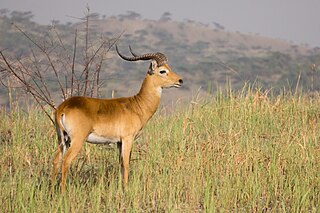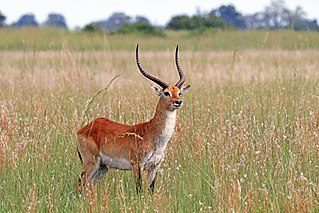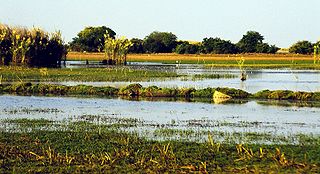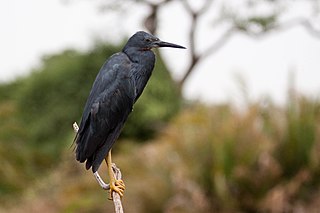
The subfamily Reduncinae is composed of nine species of antelopes, all of which dwell in marshes, floodplains, or other well-watered areas, including the waterbucks and reedbucks. These antelopes first appear in the fossil record 7.4 million years ago in Eurasia and 6.6 Mya in Africa.

The kob is an antelope found across Central Africa and parts of West Africa and East Africa. Together with the closely related reedbucks, waterbucks, lechwe, Nile lechwe, and puku, it forms the Reduncinae tribe. Found along the northern savanna, it is often seen in Murchison Falls and Queen Elizabeth National Park, Uganda; Garamba and Virunga National Park, and the Democratic Republic of the Congo, as well as grassy floodplains of South Sudan. Kob are found in wet areas, where they eat grasses. Kob are diurnal, but inactive during the heat of the day. They live in groups of either females and calves or just males. These groups generally range from five to 40 animals.

The lechwe, red lechwe or southern lechwe, is an antelope found in wetlands of south central Africa.

The Nile lechwe or Mrs Gray's lechwe is an endangered species of antelope found in swamps and grasslands in Sudan and Ethiopia.

The puku is a medium-sized antelope found in wet grasslands in southern Democratic Republic of Congo, Namibia, Tanzania, and Zambia. Nearly one-third of all puku are found in protected areas, zoos, and national parks due to their diminishing habitat.

The Bangweulu Wetlands is a wetland ecosystem adjacent to Lake Bangweulu in north-eastern Zambia. The area has been designated as one of the world's most important wetlands by the Ramsar Convention, and an "Important Bird Area" by BirdLife International. African Parks began managing Bangweulu in partnership with Zambia's Department of National Parks and Wildlife with the establishment of the Bangweulu Wetland Management Board in August 2008.

The slaty egret is a small, dark egret. It is one of the species to which the Agreement on the Conservation of African-Eurasian Migratory Waterbirds (AEWA) applies. It is classified as Vulnerable, the biggest threat being habitat loss.
The Upemba lechwe is a subspecies of antelope found only in the Upemba wetlands in the Democratic Republic of Congo. It was described in 2005, after analysis of 35 museum specimens collected in 1926 and 1947–8. Some authorities treat the Upemba lechwe as a species, K. anselli.
The Kafue Flats are a vast area of swamp, open lagoon and seasonally inundated flood-plain on the Kafue River in the Southern, Central and Lusaka provinces of Zambia. They are a shallow flood plain 240 km long and about 50 km wide, flooded to a depth of less than a meter in the rainy season, and drying out to a clayey black soil in the dry season.
Pseudoeurycea robertsi is a species of salamander in the family Plethodontidae. It is endemic to Mexico and only known from the Nevado de Toluca, near Toluca in the State of Mexico. Its common name is Roberts' false brook salamander. The specific name robertsi honors the collector of the holotype, Mr. Radclyffe Roberts from the Philadelphia Academy of Sciences.

The Zambezian flooded grasslands is an ecoregion of southern and eastern Africa that is rich in wildlife.

Kobus is a genus containing six species of African antelopes, all of which are associated with marshes, floodplains, or other grassy areas near water. They are sexually dimorphic, with females being smaller and lacking the horns of the males.
The Kafue lechwe is a subspecies of the southern lechwe. It is endemic to the Kafue Flats, Zambia. It is listed on the IUCN Red List as vulnerable.
Schistura robertsi is a species of ray-finned fish, a stone loach, in the genus Schistura. It is found on the western side of the Malay Peninsula from Tanintharyi Region in southern Myanmar to Trang Province in Peninsular Thailand and on Langkawi Island in Malaysia. It occurs in streams and hill creeks, inhabiting stretches with stream beds made up of gravel and small stones and it is threatened by developments for tourism, agriculture, livestock farming, residential property and commercial property. The specific name honours the American ichthyologist Tyson R. Roberts who collected most of the original type series which were used by Maurice Kottelat to describe the species.

Boma National Park is a protected area in eastern South Sudan near the Ethiopian border. It was established in 1977 and covers 22,800 km2 (8,800 sq mi) of grasslands and floodplains.
Omobranchus robertsi is a species of combtooth blenny found in the western central Pacific ocean, around Papua New Guinea. The specific name honours Tyson R. Roberts, the American ichthyologist.
The Cape lechwe, or Venter's lechwe, is an extinct species similar to the red lechwe, Kobus leche. It was described by Robert Broom from a frontlet and horn core from Haagenstad, which Broom believed to be an intermediate form between lechwe and waterbuck. However others have failed to find justification for separating the species from Kobus leche.

Neoromicia robtertsi is a species of vesper bat found in Madagascar. It is a recently described species, as it was first described in 2012.










